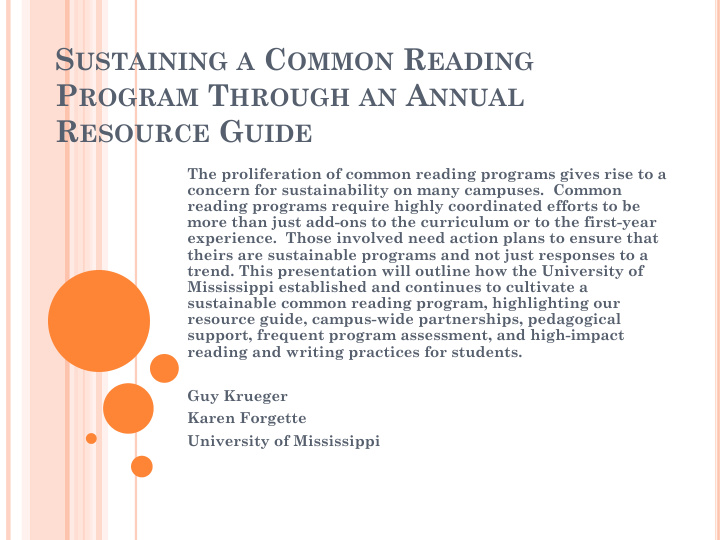



S USTAINING A C OMMON R EADING P ROGRAM T HROUGH AN A NNUAL R ESOURCE G UIDE The proliferation of common reading programs gives rise to a concern for sustainability on many campuses. Common reading programs require highly coordinated efforts to be more than just add-ons to the curriculum or to the first-year experience. Those involved need action plans to ensure that theirs are sustainable programs and not just responses to a trend. This presentation will outline how the University of Mississippi established and continues to cultivate a sustainable common reading program, highlighting our resource guide, campus-wide partnerships, pedagogical support, frequent program assessment, and high-impact reading and writing practices for students. Guy Krueger Karen Forgette University of Mississippi
W HAT ARE YOUR CONCERNS ? ¢ What should a good common reading program do? Why? ¢ What problems are occurring now? ¢ What problems do you anticipate? ¢ Is the selection of text a source of friction? ¢ Who has agency in the program?
W HAT WERE / ARE OUR CONCERNS ? ¢ How comfortable would our teachers be with teaching the book? ¢ How could we encourage campus-wide involvement? ¢ How would we assess the program’s value?
I NCREASING P EDAGOGICAL S UPPORT ¢ EDHE Workshops and Course Resource Page
I NCREASING P EDAGOGICAL S UPPORT ¢ Resource Guide
W HAT ARE YOUR PEDAGOGICAL NEEDS AND CHALLENGES ? A NY STRATEGIES FOR ADDRESSING THEM ? ¢ Are those needs/challenges specific to your university or more widely applicable? ¢ Are there other viable solutions?
I NCREASING I NVESTMENT A CROSS C AMPUS ¢ At UM, we Partnered with the Nursing faculty Folded in the ROTC Reached out to faculty who had expertise related to the book, e.g., Physics Expanded the library’s role
W HAT ARE YOUR STRATEGIES FOR OR QUESTIONS ABOUT INCREASING INVESTMENT ? ¢ What strategies have worked on your campus? ¢ What hasn’t worked or won’t work? ¢ Are there people and/or departments who could function as potential partners on your campus? ¢ What are some strategies for increasing investment on a limited budget?
C OLLECTING F EEDBACK ¢ Survey data “All of my peers are enrolled in different courses with different teachers, and this allowed for us to discuss something we all had to do.” ~ Student response from survey
C OLLECTING F EEDBACK ¢ Stakeholder interviews “Having EDHE instructors involved in the creation of the • Common Reading Resource Guide helps to ensure that our freshmen students (most of whom are enrolled in [Writing and EDHE] in the Fall) aren’t repeating the same discussions and materials.” ~EDHE instructor “ While the book is handed out at summer orientation, and the • author of the book speaks at August Convocation, we have had success in generating a semester-long interest in the book by embedding it into classes for First Year Writing and the First Year Experience. This built-in potential audience ... drives the planning for events that will be engaging for them and also cast an attractive net onto the rest of the campus community.” ~ Librarian
U NSOLICITED F EEDBACK From a student in a course not using the CRT “This one sentence provoked me to think of several situations all at once. At first, I thought about reading The Unforgiving Minute and how Craig Mullaney constantly pushed himself to ask questions and to understand ways that he never would before. Reading that book during the summer before my freshmen year of college challenged me to ask my own questions and to truly figure out who I am and to learn to be proud of who I am and where I come from. With that said, I have learned to become more open minded and curious about other traditions, faiths, and customs here on campus.”
H OW DO YOU COLLECT FEEDBACK ? ¢ Other methods? ¢ Problems?
S TRATEGIES FOR S USTAINABILITY ¢ Identify a dedicated group of two-three committee members who will be part of the guide’s creation each year to help plan, organize, troubleshoot, and draw from previous experience. ¢ Rotate in other faculty/staff on campus to help work on the guide’s creation. ¢ Involve the campus library. ¢ Assess the program often and from multiple sources including students, instructors, and stakeholders.
Recommend
More recommend